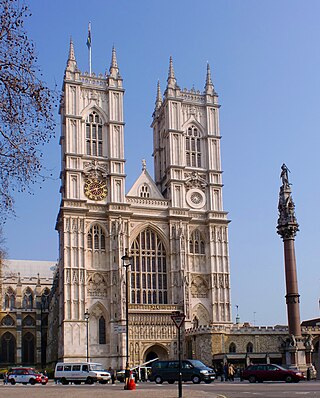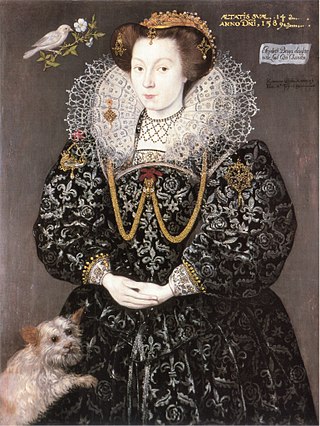Related Research Articles

Westminster Abbey, formally titled the Collegiate Church of Saint Peter at Westminster, is an Anglican church in the City of Westminster, London, England. Since 1066, it has been the location of the coronations of 40 English and British monarchs, and a burial site for 18 English, Scottish, and British monarchs. At least 16 royal weddings have occurred at the abbey since 1100.

Robert Cecil, 1st Earl of Salisbury, was an English statesman noted for his direction of the government during the Union of the Crowns, as Tudor England gave way to Stuart rule (1603). Lord Salisbury served as the Secretary of State of England (1596–1612) and Lord High Treasurer (1608–1612), succeeding his father as Queen Elizabeth I's Lord Privy Seal and remaining in power during the first nine years of King James I's reign until his own death.

Grinling Gibbons was an Anglo-Dutch sculptor and wood carver known for his work in England, including Windsor Castle and Hampton Court Palace, St Paul's Cathedral and other London churches, Petworth House and other country houses, Trinity College, Oxford, and Trinity College, Cambridge. Gibbons was born to English parents in Holland, where he was educated.

Thomas Sackville, 1st Earl of Dorset was an English statesman, poet, and dramatist. He was the son of Richard Sackville, a cousin to Anne Boleyn. He was a Member of Parliament and Lord High Treasurer.

Edward Seymour, 1st Earl of Hertford, 1st Baron Beauchamp, KG, of Wulfhall and Totnam Lodge in Great Bedwyn, Wiltshire, of Hatch Beauchamp in Somerset, of Netley Abbey, Hampshire, and of Hertford House, Cannon Row in Westminster, is most noted for incurring the displeasure of Queen Elizabeth I by taking part in more than one clandestine marriage.

George Home, 1st Earl of Dunbar, KG, PC was, in the last decade of his life, the most prominent and most influential Scotsman in England. His work lay in the King's Household and in the control of the State Affairs of Scotland and he was the King's chief Scottish advisor. With the full backing and trust of King James he travelled regularly from London to Edinburgh via Berwick-upon-Tweed.

Giles Daubeney, 1st Baron Daubeney, KG PC was an English soldier, diplomat, courtier and politician.
John Bushnell (1636–1701) was an English sculptor, known for several outstanding funeral monuments in English churches including Westminster Abbey.
Sir David Foulis was a Scottish baronet and politician.

Mary Stuart was the third daughter and sixth child of James VI and I by Anne of Denmark. Her birth was much anticipated. She developed pneumonia at 17 months and died the following year.

Thomas Fowler was an English lawyer, diplomat, courtier, spy, servant of the Countess of Lennox, broker of the marriage of Mary, Queen of Scots and Lord Darnley, steward of the Earl of Leicester, advisor to James VI of Scotland and the Scottish ambassador in London, Archibald Douglas.

Elizabeth Brydges was a courtier and aristocrat, Maid of Honour to Elizabeth I, and victim of bigamy. She was a daughter of Giles Brydges, 3rd Baron Chandos, and Frances Clinton, who lived at Sudeley Castle.
Mary Middlemore was a Courtier and Maid of Honour to Anne of Denmark, subject of poems, and treasure hunter.

Dr Martin Schöner or Schönerus, physician to James VI and I and Anne of Denmark.
Andrew Melville of Garvock was a Scottish courtier and servant of Mary, Queen of Scots.

The coronation of James I and his wife Anne as King and Queen of England and Ireland was held on 25 July 1603 at Westminster Abbey. James had reigned as King James VI of Scotland since 1567. Anne was anointed and consecrated with prayers alluding to Esther, the Wise Virgins, and other Biblical heroines. It was the first coronation to be conducted in English instead of Latin. A planned ceremonial Royal Entry to London was deferred until 15 March 1604.

Sophia Stuart was the fourth daughter and last of nine children of James VI and I and Anne of Denmark.

James VI and I (1566–1625), King of England, Scotland, and Ireland, died on 27 March 1625 at Theobalds, and was buried at Westminster Abbey on 7 May 1625.

Anne of Denmark (1574–1619) was the wife of James VI and I, and queen consort of Scotland from 1589, and queen consort of England and Ireland from the union of the Scottish and English crowns in 1603 until her death on 2 March 1619 at Hampton Court. She was buried at Westminster Abbey on 13 May.
Mary I of England died on 17 November 1558 at St James's Palace in London. She was 42 years old. Mary was buried in Westminster Abbey on 14 December.
References
- Lee, Sidney (1887). . In Stephen, Leslie (ed.). Dictionary of National Biography . Vol. 11. London: Smith, Elder & Co. pp. 407–408.
- Esdaile, K.A. (1946). English Church Monuments 1510–1840. Batsford.